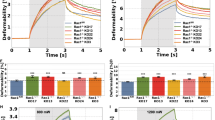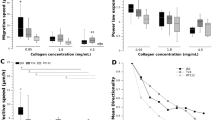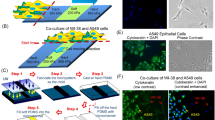Abstract
The motility of cancer cells in 3D matrices is of two types: mesenchymal motility, in which the cells are elongated and amoeboid motility, in which the cells are round. Amoeboid motility is driven by an actomyosin-based contractile force, which is regulated by the Rho/ROCK pathway. However, the molecular mechanisms underlying the motility of elongated cells remain unknown. Here, we show that the motility of elongated cells is regulated by Rac signaling through the WAVE2/Arp2/3-dependent formation of elongated pseudopodia and cell-substrate adhesion in 3D substrates. The involvement of Rac signaling in cell motility was different in cell lines that displayed an elongated morphology in 3D substrates. In U87MG glioblastoma cells, most of which exhibit mesenchymal motility, inhibition of Rac signaling blocked the invasion of these cells in 3D substrates. In HT1080 fibrosarcoma cells, which display mixed cell motility involving both elongated and rounded cells, inhibition of Rac1 signaling not only blocked mesenchymal motility but also caused a mesenchymal–amoeboid transition. Additionally, Rac1 and RhoA signaling regulated the mesenchymal and amoeboid motility in these cells, respectively, and the inhibition of both pathways dramatically decreased cell invasion. Hence, we could conclude that Rac1 and RhoA signaling simultaneously regulate cell invasion in 3D matrices.
This is a preview of subscription content, access via your institution
Access options
Subscribe to this journal
Receive 50 print issues and online access
$259.00 per year
only $5.18 per issue
Buy this article
- Purchase on Springer Link
- Instant access to full article PDF
Prices may be subject to local taxes which are calculated during checkout







Similar content being viewed by others
References
Burridge K, Wennerberg K . (2004). Rho and Rac take center stage. Cell 116: 167–179.
Carragher NO, Walker SM, Scott Carragher LA, Harris F, Sawyer TK, Brunton VG et al. (2006). Calpain 2 and Src dependence distinguishes mesenchymal and amoeboid modes of tumour cell invasion: a link to integrin function. Oncogene 25: 5726–5740.
Chan AY, Coniglio SJ, Chuang YY, Michaelson D, Knaus UG, Philips MR et al. (2005). Roles of the Rac1 and Rac3 GTPases in human tumor cell invasion. Oncogene 24: 7821–7829.
Fackler OT, Grosse R . (2008). Cell motility through plasma membrane blebbing. J Cell Biol 181: 879–884.
Friedl P . (2004). Prespecification and plasticity: shifting mechanisms of cell migration. Curr Opin Cell Biol 16: 14–23.
Friedl P, Wolf K . (2003). Tumour-cell invasion and migration: diversity and escape mechanisms. Nat Rev Cancer 3: 362–374.
Furutani M, Itoh T, Ijuin T, Tsujita K, Takenawa T . (2006). Thin layer chromatography-blotting, a novel method for the detection of phosphoinositides. J Biochem (Tokyo) 139: 663–670.
Gadea G, de Toledo M, Anguille C, Roux P . (2007). Loss of p53 promotes RhoA-ROCK-dependent cell migration and invasion in 3D matrices. J Cell Biol 178: 23–30.
Goldberg L, Kloog Y . (2006). A Ras inhibitor tilts the balance between Rac and Rho and blocks phosphatidylinositol 3-kinase-dependent glioblastoma cell migration. Cancer Res 66: 11709–11717.
Griffith LG, Swartz MA . (2006). Capturing complex 3D tissue physiology in vitro. Nat Rev Mol Cell Biol 7: 211–224.
Guo F, Debidda M, Yang L, Williams DA, Zheng Y . (2006). Genetic deletion of Rac1 GTPase reveals its critical role in actin stress fiber formation and focal adhesion complex assembly. J Biol Chem 281: 18652–18659.
Hall A . (2005). Rho GTPases and the control of cell behaviour. Biochem Soc Trans 33: 891–895.
Iwaya K, Norio K, Mukai K . (2007a). Coexpression of Arp2 and WAVE2 predicts poor outcome in invasive breast carcinoma. Mod Pathol 20: 339–343.
Iwaya K, Oikawa K, Semba S, Tsuchiya B, Mukai Y, Otsubo T et al. (2007b). Correlation between liver metastasis of the colocalization of actin-related protein 2 and 3 complex and WAVE2 in colorectal carcinoma. Cancer Sci 98: 992–999.
Kitzing TM, Sahadevan AS, Brandt DT, Knieling H, Hannemann S, Fackler OT et al. (2007). Positive feedback between Dia1, LARG, and RhoA regulates cell morphology and invasion. Genes Dev 21: 1478–1483.
Kurisu S, Suetsugu S, Yamazaki D, Yamaguchi H, Takenawa T . (2005). Rac-WAVE2 signaling is involved in the invasive and metastatic phenotypes of murine melanoma cells. Oncogene 24: 1309–1319.
Meshel AS, Wei Q, Adelstein RS, Sheetz MP . (2005). Basic mechanism of three-dimensional collagen fibre transport by fibroblasts. Nat Cell Biol 7: 157–164.
Nakazawa T, Watabe AM, Tezuka T, Yoshida Y, Yokoyama K, Umemori H et al. (2003). p250GAP, a novel brain-enriched GTPase-activating protein for Rho family GTPases, is involved in the N-methyl-d-aspartate receptor signaling. Mol Biol Cell 14: 2921–2934.
Ohta Y, Hartwig JH, Stossel TP . (2006). FilGAP, a Rho- and ROCK-regulated GAP for Rac binds filamin A to control actin remodelling. Nat Cell Biol 8: 803–814.
Paluch E, Sykes C, Prost J, Bornens M . (2006). Dynamic modes of the cortical actomyosin gel during cell locomotion and division. Trends Cell Biol 16: 5–10.
Pampaloni F, Reynaud EG, Stelzer EH . (2007). The third dimension bridges the gap between cell culture and live tissue. Nat Rev Mol Cell Biol 8: 839–845.
Sabeh F, Ota I, Holmbeck K, Birkedal-Hansen H, Soloway P, Balbin M et al. (2004). Tumor cell traffic through the extracellular matrix is controlled by the membrane-anchored collagenase MT1-MMP. J Cell Biol 167: 769–781.
Sahai E, Garcia-Medina R, Pouyssegur J, Vial E . (2007). Smurf1 regulates tumor cell plasticity and motility through degradation of RhoA leading to localized inhibition of contractility. J Cell Biol 176: 35–42.
Sahai E . (2005). Mechanisms of cancer cell invasion. Curr Opin Genet Dev 15: 87–96.
Sahai E . (2007). Illuminating the metastatic process. Nat Rev Cancer 7: 737–749.
Sahai E, Marshall CJ . (2002). RHO-GTPases and cancer. Nat Rev Cancer 2: 133–142.
Sahai E, Marshall CJ . (2003). Differing modes of tumour cell invasion have distinct requirements for Rho/ROCK signalling and extracellular proteolysis. Nat Cell Biol 5: 711–719.
Sanz-Moreno V, Gadea G, Ahn J, Paterson H, Marra P, Pinner S et al. (2008). Rac activation and inactivation control plasticity of tumor cell movement. Cell 135: 510–523.
Semba S, Iwaya K, Matsubayashi J, Serizawa H, Kataba H, Hirano T et al. (2006). Coexpression of actin-related protein 2 and Wiskott-Aldrich syndrome family verproline-homologous protein 2 in adenocarcinoma of the lung. Clin Cancer Res 12: 2449–2454.
Suetsugu S, Yamazaki D, Kurisu S, Takenawa T . (2003). Differential roles of WAVE1 and WAVE2 in dorsal and peripheral ruffle formation for fibroblast cell migration. Dev Cell 5: 595–609.
Takenawa T, Suetsugu S . (2007). The WASP-WAVE protein network: connecting the membrane to the cytoskeleton. Nat Rev Mol Cell Biol 8: 37–48.
Torka R, Thuma F, Herzog V, Kirfel G . (2006). ROCK signaling mediates the adoption of different modes of migration and invasion in human mammary epithelial tumor cells. Exp Cell Res 312: 3857–3871.
Vial E, Sahai E, Marshall CJ . (2003). ERK-MAPK signaling coordinately regulates activity of Rac1 and RhoA for tumor cell motility. Cancer Cell 4: 67–79.
Wilkinson S, Paterson HF, Marshall CJ . (2005). Cdc42-MRCK and Rho-ROCK signalling cooperate in myosin phosphorylation and cell invasion. Nat Cell Biol 7: 255–261.
Wolf K, Mazo I, Leung H, Engelke K, von Andrian UH, Deryugina EI et al. (2003). Compensation mechanism in tumor cell migration: mesenchymal-amoeboid transition after blocking of pericellular proteolysis. J Cell Biol 160: 267–277.
Wolf K, Wu YI, Liu Y, Geiger J, Tam E, Overall C et al. (2007). Multi-step pericellular proteolysis controls the transition from individual to collective cancer cell invasion. Nat Cell Biol 9: 893–904.
Wyckoff JB, Pinner SE, Gschmeissner S, Condeelis JS, Sahai E . (2006). ROCK- and myosin-dependent matrix deformation enables protease-independent tumor-cell invasion in vivo. Curr Biol 16: 1515–1523.
Yamada KM, Cukierman E . (2007). Modeling tissue morphogenesis and cancer in 3D. Cell 130: 601–610.
Yamazaki D, Kurisu S, Takenawa T . (2005). Regulation of cancer cell motility through actin reorganization. Cancer Sci 96: 379–386.
Yamazaki D, Suetsugu S, Miki H, Kataoka Y, Nishikawa S, Fujiwara T et al. (2003). WAVE2 is required for directed cell migration and cardiovascular development. Nature 424: 452–456.
Yip SC, El-Sibai M, Coniglio SJ, Mouneimne G, Eddy RJ, Drees BE et al. (2007). The distinct roles of Ras and Rac in PI 3-kinase-dependent protrusion during EGF-stimulated cell migration. J Cell Sci 120: 3138–3146.
Acknowledgements
We thank for Dr T Azuma for providing cancer cell lines. We are grateful to Dr T Yamamoto and Dr T Nakazawa for providing GST-Rhotekin-RBD.
Author information
Authors and Affiliations
Corresponding author
Additional information
Supplementary Information accompanies the paper on the Oncogene website (http://www.nature.com/onc)
Supplementary information
Rights and permissions
About this article
Cite this article
Yamazaki, D., Kurisu, S. & Takenawa, T. Involvement of Rac and Rho signaling in cancer cell motility in 3D substrates. Oncogene 28, 1570–1583 (2009). https://doi.org/10.1038/onc.2009.2
Received:
Revised:
Accepted:
Published:
Issue Date:
DOI: https://doi.org/10.1038/onc.2009.2
Keywords
This article is cited by
-
Oncogenic and immunological roles of RACGAP1 in pan-cancer and its potential value in nasopharyngeal carcinoma
Apoptosis (2024)
-
RacGAP1 promotes the malignant progression of cervical cancer by regulating AP-1 via miR-192 and p-JNK
Cell Death & Disease (2022)
-
Rho GTPases in cancer radiotherapy and metastasis
Cancer and Metastasis Reviews (2020)
-
The role of collagen in cancer: from bench to bedside
Journal of Translational Medicine (2019)
-
Morphoregulatory functions of the RNA-binding motif protein 3 in cell spreading, polarity and migration
Scientific Reports (2018)



